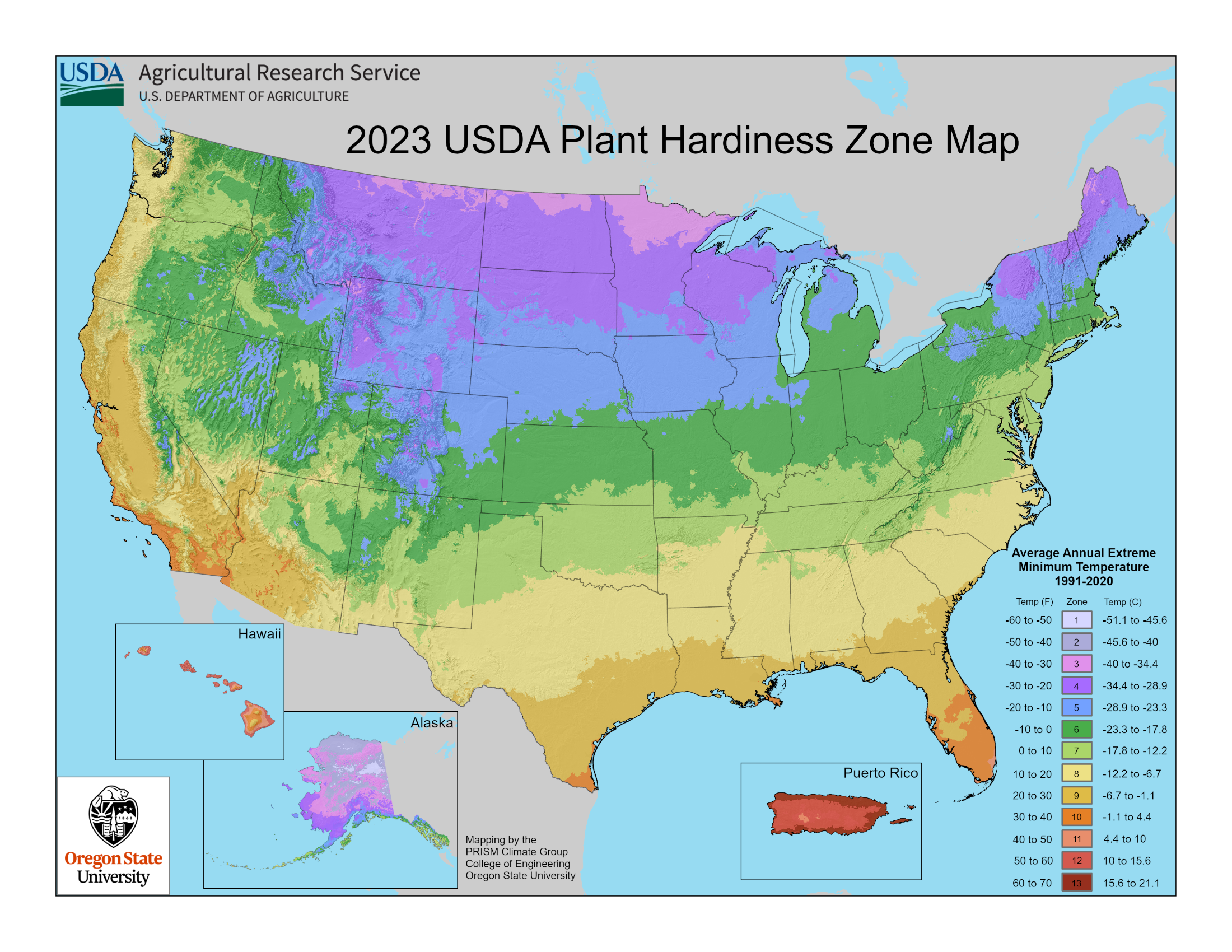USDA Hardiness Zones
Find Your USDA Hardiness Zone
Knowing your growing zone helps determine which plants will thrive in your climate.
Zone Map
The USDA Plant Hardiness Zone Map is the standard by which gardeners can determine which plants are most likely to thrive in their location. The map is based on the average annual minimum winter temperature, divided into 13 zones.

Understanding USDA Hardiness Zones
USDA Hardiness Zones divide North America into regions based on average annual minimum winter temperatures. Each zone represents a 10°F difference, with subzones (a/b) representing 5°F increments. This system helps gardeners determine which plants are likely to survive in their climate.
Zone Descriptions
Zone 2: -50°F to -40°F
Very short growing season (90-100 days), extremely cold winters
Zone 3: -40°F to -30°F
Short growing season (120-150 days), very cold winters
Zone 4: -30°F to -20°F
Cold winters, spring frosts possible until late May
Zone 5: -20°F to -10°F
Cold winters, moderate growing season (150-175 days)
Zone 6: -10°F to 0°F
Moderate growing season (175-200 days), cold winters
Zone 7: 0°F to 10°F
Long growing season (200+ days), mild winters
Zone 8: 10°F to 20°F
Long growing season, mild winters, hot summers
Zone 9: 20°F to 30°F
Very long growing season, mild winters, hot summers
Zone 10: 30°F to 40°F
Nearly year-round growing, very mild winters
Zone 11: Above 40°F
Year-round growing, frost-free tropical climate
General Planting Guidelines by Zone
Cold Zones (2-4)
- Start cool-season crops indoors 6-8 weeks before last frost
- Focus on cold-hardy vegetables: kale, spinach, carrots, potatoes
- Use season extenders like cold frames and row covers
- Choose short-season varieties (70 days or less to maturity)
- Plant perennials rated for at least one zone colder than yours
Moderate Zones (5-7)
- Good balance of cool and warm-season crops
- Start warm-season crops after soil temperatures reach 60°F
- Use succession planting for continuous harvests
- Fall garden opportunities with second plantings of cool-season crops
- Great for most perennial fruits and ornamentals
Warm Zones (8-10)
- Focus on heat-tolerant varieties during summer
- May need shade cloth for cool-season crops
- Consider two main growing seasons: spring and fall
- Some warm regions have summer gardening breaks due to extreme heat
- Winter growing season for cool-season crops
Frost Date Considerations
Your frost dates are crucial for successful gardening, even more specific than your zone:
Spring Planning:
- Last spring frost marks when it's safe to plant tender crops outdoors
- Start seeds indoors 4-8 weeks before last frost date
- Harden off seedlings by gradually introducing them to outdoor conditions
Fall Planning:
- First fall frost date signals the end of the growing season for tender plants
- Calculate planting dates for fall crops by counting back from first frost date
- Use row covers to extend your season beyond first light frosts
Microclimate Factors
Your garden may have conditions that differ from the overall zone:
Urban Heat Islands
City environments may be 5-10°F warmer than surrounding areas
Water Proximity
Lakes, rivers, and oceans moderate temperatures
Elevation
Higher elevations experience colder temperatures
Slope Direction
South-facing slopes are warmer than north-facing slopes
Wind Exposure
Wind can significantly lower effective temperatures
Structures
Buildings, walls, and hardscaping can create warmer microclimates
Seasonal Adaptations
Cold Zones (2-4):
- Focus on rapid spring soil warming with raised beds
- Use season extenders: cold frames, row covers, greenhouses
- Select fast-maturing varieties
Moderate Zones (5-7):
- Balance cool and warm-season crops
- Plant cool-season crops in early spring and fall
- Plant warm-season crops after soil warms
Warm Zones (8-10):
- Consider summer dormancy for some plants
- Focus on heat-tolerant varieties
- Plant cool-season crops in fall through spring